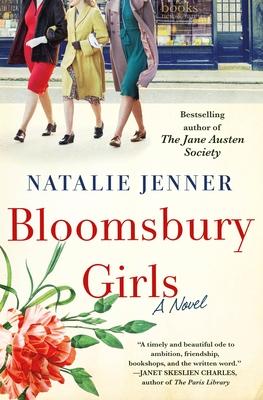I liked the idea of this book better than I liked the book itself. It’s set in 1950’s London, in a fictional shop called Bloomsbury Books. It centers around three women: Grace, who’s in an abusive marriage; Vivien, who longs to write and to manage the bookstore rather than merely stand at the cash register; and Evie, who recently graduated from Cambridge and feels she was unfairly denied a position working for one of the professors.

Two things made this book stand out for me. One is the setting of post-war London, where everyone is impacted in some way by recent events. Some of the men have come back traumatized, while others escaped the action or were not able to fight. Women were elevated in jobs and in higher education, and are now dealing with a society they thought would allow them to grow, but instead wants to put them back in their place. One characters is an immigrant from India, who’s come to advance his career and seek new opportunities, but instead experiences constant and overt racism.
The second thing that made this book stand out is the use of real life literary and publishing figures, such as Daphne DuMaurier, Sonia Brownell (wife of George Orwell), Peggy Guggenheim, Samuel Beckett, and Ellen Doubleday, wife of the American publisher. The real-life characters were what made this book particularly interesting to me, although I was disappointed by the lack of an explanation by the author of what was true and what was fictional (though we do learn that Sunwise Turn was an actual bookstore).
I enjoyed Tanner’s depiction of the three main characters, and the struggles they undergo. Grace feels she has to accept her life as it is, even though she feels like she’s imprisoned by her husband. Vivien goes through life challenging everything, which makes her an impressive figure to the other woman, but just being angry isn’t a way to find fulfillment and happiness. And Evie is brilliant but follows the rules too much, which I identified with, and doesn’t always see people for who they are.
I appreciated these three strong female characters and the ways that sexism and racism, both overt and subtle, holds the characters back. In a way, some of the most thoughtful moments in this book are seen through the eyes of the male characters, as they struggle to redefine their relationships with the women they care about.
Ironically, the other men in the shop had turned out to be just as unsuccessful at separating love from work. Alec now knew all their business dealings to have been a facade for more emotional yearnings, while the women appeared to have kept their eyes on business all along.
Bloomsbury Girls by Natalie Jenner
This book is not billed as a sequel to Jenner’s The Jane Austen Society, but maybe it should have been. Evie and friends Mimi and Yardley come from that book, and her story in this book is very much a continuation of the events in the first book. I found myself frustrated by the frequent references to the book, because if I’d known this was basically a sequel I would have read the other book first.
If you read Jane Austen Society and loved it, I expect you’ll love this book as well. For me, it was fine but not momentous. I enjoyed reading about the literary figures and the reading and publishing world in 1950’s England. But Jenner’s writing style was a bit repetitive and had a bit too much “telling” for my taste. While there are some insightful moments, for the most part this story rolls out exactly as expected. This is a book where the characters lead complicated lives, which I appreciated, but ultimately the story is wrapped up too neatly, too easily.
This was an entertaining read, and I certainly loved its bookstore setting. It’s a book that other readers on Goodreads describe as “charming” and “sweet” — which I suppose is why it ultimately didn’t work as well for me.
Note: I received an advanced review copy of this book from NetGalley and publisher St. Martin’s Press. The book published May 17, 2022.

